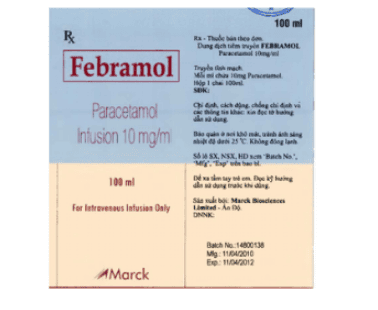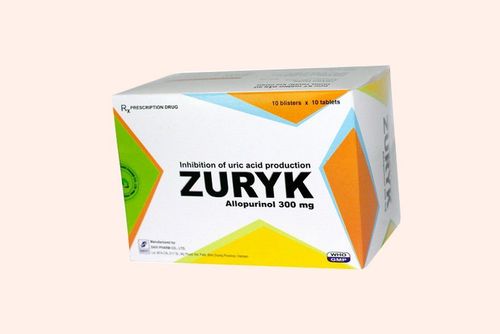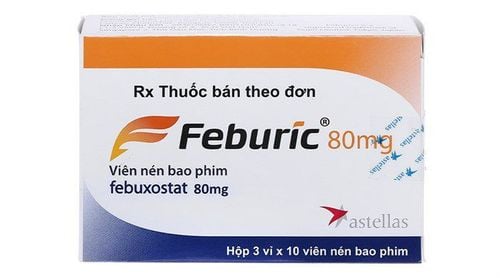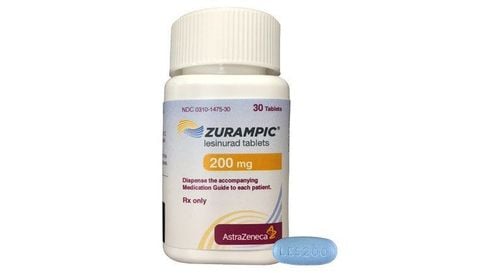This is an automatically translated article.
Gutacin medicine has the main active ingredient Colchicine with a concentration of 1mg and other excipients in a sufficient amount. This is a non-steroid pain reliever, antipyretic, anti-inflammatory drug that is used in the treatment of osteoarthritis and gout.1. What is Gutacin?
What is Gutacin? Gutacin medicine has the main active ingredient Colchicine with a concentration of 1mg and other excipients in a sufficient amount. This is a non-steroid pain reliever, antipyretic, anti-inflammatory drug that is used in the treatment of osteoarthritis and gout.
Gutacin is made in the form of tablets, suitable for direct oral use. Packing is a box of 5 blisters or 10 blisters and each blister contains 10 pills.
1.1. Pharmacodynamics of active ingredient Colchicin Anti-gout effect: Active ingredient Colchicin reduces the migration of white blood cells, inhibits phagocytosis of urate microcrystals and thereby reduces the formation of lactic acid. At the same time, this active ingredient also keeps the local pH normal because the acidic pH is the factor that facilitates the precipitation of Urate crystals in the tissues of the joints. Active ingredient Colchicine does not affect the concentration of uric acid in the blood and the excretion of uric acid in the urine. Anti-inflammatory effect at a weak level, according to a non-specific mechanism: Active ingredient Colchicine reduces the migration of leukocytes, inhibits the chemotaxis, metabolism and function of polymorphonuclear leukocytes, leading to a decrease inflammatory reactions. 1.2. Pharmacokinetics of the active ingredient Colchicine Active ingredient Colchicine is absorbed from the gastrointestinal tract and enters the enterohepatic circulation. Peak plasma concentrations occur about 2 hours after dosing. Drugs penetrate into tissues, especially intestinal mucosa, liver, kidney, spleen, except heart muscle, skeletal muscle and lung. Colchicine is eliminated mainly in the feces and a small part in the urine. When the daily dose is higher than 1mg, Colchicine will accumulate in tissues and can lead to toxicity.
2. What disease does Gutacin treat?
Gutacin is used in the treatment of the following diseases:
Acute exacerbations of Gout; Treatment of gout recurrence, prevention of acute attacks of gout in the first few months when establishing a treatment regimen with drugs to lower uric acid in the blood, drugs that cause uricuria (increase uric acid excretion). ). Treatment of acute osteochondritis with calcification, sarcoid arthritis, arthritis with erythema nodules. Treatment of cyclic fever.
3. Usage and dosage of Gutacin
Gutacin is made in the form of tablets, suitable for direct oral use. Depending on the medical condition, the doctor will give different appropriate doses, specifically:
3.1. Treatment of acute gout attacks Day 1: take 3 tablets x 1mg (divided into morning, noon and evening 1 tablet each time). Days 2 and 3: take 2 tablets x 1mg (1 tablet in the morning and 1 in the evening). Day 4 and the following days: take 1 capsule in the evening. The total therapeutic dose should not exceed 10 tablets. The next treatment must be at least 3 days apart from the previous one. 3.2. Prophylaxis of acute gout attacks In the first stage of treatment with drugs that lower blood uric acid such as Allopurinol or drugs that increase uric acid excretion take 1 tablet, the time to take the drug is in the evening.
3.3. Treatment of acute microscopic arthritis, cyclic fever With this form of disease, you take 1 tablet in the evening.
For people with kidney failure, with serum creatinine concentration greater than or equal to 1.6 mg/100 ml, or creatinine clearance less than or equal to 50 ml/min: take 1⁄2 tablets/ The total dose used in a course of treatment should not exceed 4 tablets per day. The next treatment must be at least 3 days apart from the previous one.
4. Gutacin overdose and how to handle it
The toxic dose is about 10 mg. Accordingly, the dose that is always fatal is a dose above 40mg. Symptoms of poisoning appear 1 to 8 hours after taking the drug, with an average of 3 hours, and may include: severe and diffuse abdominal pain, vomiting, paralytic ileus, and diarrhea that may be bloody. , leading to dehydration (metabolic acidosis) and circulatory disturbances causing hypotension. In addition, people using the drug overdose may also experience gastritis, pain in the joints, low blood calcium, fever, rash, .... Difficult prognosis when overdose of active ingredient Colchicine or drugs Gutacin usually dies on the 2nd or 3rd day due to water-electrolyte disturbance, respiratory failure, cardiovascular collapse and sepsis. Treatment of Overdose: There is currently no specific treatment for Colchicine poisoning and overdose. The doctor may prescribe gastric lavage followed by duodenal suction and activated charcoal to increase the excretion of active substances. Supportive treatment measures are to restore water-electrolyte balance, use systemic antibiotics and gastrointestinal antibiotics in high doses. At the same time, doctors may prescribe Atropin or Morphin injections with the effect of reducing abdominal pain, using anti-shock therapy methods, giving oxygen. If the user has impaired kidney function, the doctor may prescribe hemodialysis or peritoneal dialysis.
5. Undesirable effects of the drug Gutacin
During the use of Gutacin, you may experience undesirable effects, specifically as follows:
Digestive disorders: nausea, vomiting, abdominal pain, diarrhea. These are the first signs of an overdose, and treatment should be reduced or discontinued until the above symptoms have resolved, and usually after 24 to 48 hours. Urticaria and measles-like rash appear on the skin. Hematologic disorders: decrease in white blood cell count, decrease in neutrophil count, decrease in platelet count (may be seen in case of long-term treatment). Decreased sperm count but reversible. Neuromuscular disorders are reversible upon discontinuation of treatment, hair loss. When there are undesirable effects, it must be understood that it is the first sign of poisoning, the patient should stop using the drug containing Colchicine or reduce the dose. Patients need to proactively notify the doctor to treat unwanted effects encountered when taking Gutacin.
6. Gutacin drug interactions
Interactions of Gutacin drugs may occur during use as follows:
Concurrent use of drugs containing active ingredients Colchicin and Ciclosporin increases the toxicity of Ciclosporin. Colchicine reduces the absorption of Vitamin B12 by acting on the small intestine mucosa. This absorption can be reversed.
7. Some notes when using Gutacin
7.1. Gutacin is contraindicated in the following cases:
People with hypersensitivity to the main active ingredient Colchicin or one of its ingredients. People with severe kidney or liver failure. Woman is pregnant. People at risk of narrow-angle glaucoma have urinary retention. 7.2. Precautions of Gutacin When taking Gutacin to treat acute gout attacks: caution should be exercised in people with renal or hepatic impairment. With caution in people with cardiovascular disease, liver disease, kidney disease or digestive disease. Debilitated elderly patients are more susceptible to toxicity from drug accumulation. When using Gutacin for long-term treatment, it is necessary to regularly monitor the patient to see if there are any unwanted effects, and to monitor the blood count. Colchicine is excreted in breast milk. Currently, the infant has not been found to be poisoned through milk, but the mother can avoid high drug concentration in milk by taking Gutacin at night before going to bed and breastfeeding after 8 hours of taking the drug. Above is all information about Gutacin, patients need to carefully read the instructions for use, consult a doctor / pharmacist before using. Absolutely do not arbitrarily buy Gutacin to treat the disease at home, because there may be unwanted side effects on health.
Follow Vinmec International General Hospital website to get more health, nutrition and beauty information to protect the health of yourself and your loved ones in your family.













